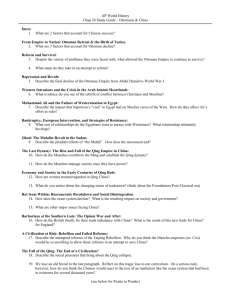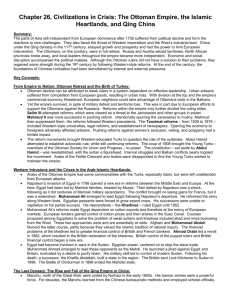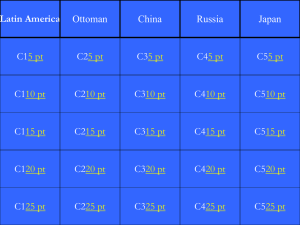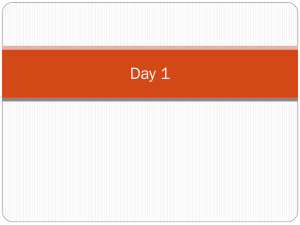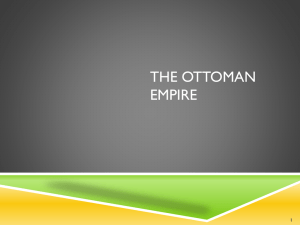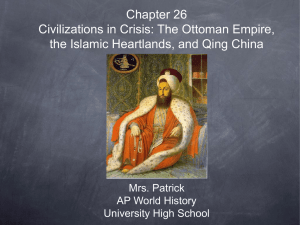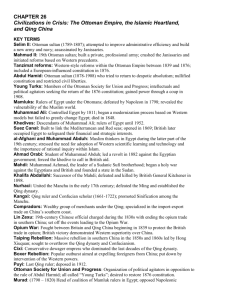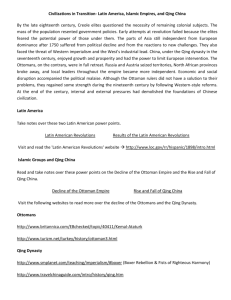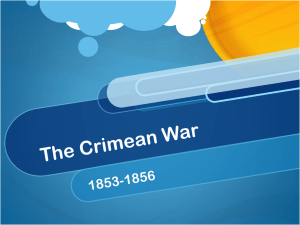Chapter 26: Civilizations in Crisis: the Ottoman Empire, the Islamic
advertisement
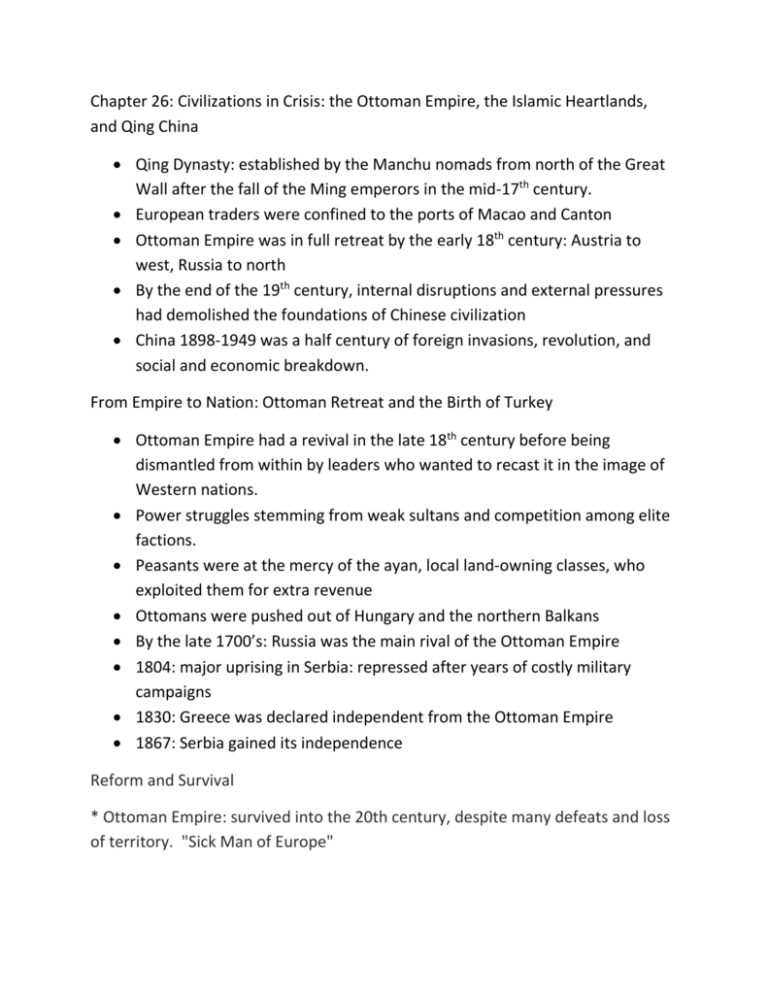
Chapter 26: Civilizations in Crisis: the Ottoman Empire, the Islamic Heartlands, and Qing China Qing Dynasty: established by the Manchu nomads from north of the Great Wall after the fall of the Ming emperors in the mid-17th century. European traders were confined to the ports of Macao and Canton Ottoman Empire was in full retreat by the early 18th century: Austria to west, Russia to north By the end of the 19th century, internal disruptions and external pressures had demolished the foundations of Chinese civilization China 1898-1949 was a half century of foreign invasions, revolution, and social and economic breakdown. From Empire to Nation: Ottoman Retreat and the Birth of Turkey Ottoman Empire had a revival in the late 18th century before being dismantled from within by leaders who wanted to recast it in the image of Western nations. Power struggles stemming from weak sultans and competition among elite factions. Peasants were at the mercy of the ayan, local land-owning classes, who exploited them for extra revenue Ottomans were pushed out of Hungary and the northern Balkans By the late 1700’s: Russia was the main rival of the Ottoman Empire 1804: major uprising in Serbia: repressed after years of costly military campaigns 1830: Greece was declared independent from the Ottoman Empire 1867: Serbia gained its independence Reform and Survival * Ottoman Empire: survived into the 20th century, despite many defeats and loss of territory. "Sick Man of Europe" * British were worried that if the Ottoman Empire dismantled, Russia would get Istanbul and threaten British dominance of the Med Sea * Ultimately, the Ottomans' survival depended on reforms form within, initiated by the sultans and their advisors at the top of the imperial system and carried out in stages over most of the 19th century * Sultan Selim III (1789-1807) tried to strengthen army and navy and improved administrative efficiency: angered powerful elites and led to being overthrown by a group of janissaries who felt his reforms threatened their positions. * Sultan Mahmud II: secretly built a professional army, 1826 his agents incited a mutiny of the Janissaries. Confrontation between Janissaries and his newly trained army led to the slaughter of the Janissaries, their families, and the Janissaries' religious allies. * Mahmud II: then tried to extend reforms, based on Western precedents (more secular) and westernization of the army. * Tanzimat Reforms (1839-1876): Western-influenced reforms: revamped university education, sciences and mathematics, state-run postal and telegraph systems, railways, newspapers, 1876 Constitution. * Women's roles had little change, although it was debated Repression and Revolt * Westernized officials began to see Sultan as a barrier to further reforms * Sultan Abdul Hamid: tried to return to despotic absolutism from 1878 to 1908. Nullified Constitution, restricted civil liberties, dissidents silenced. * Nearly bloodless coup of 1908 ended Abdul Hamid's reign * Ottoman Society for Union and Progress- formed by exiled Turkish intellectuals and political agitators in Paris in 1889. Known as the "Young Turks". Wanted to re-establish the 1876 Constitution * Group of military officers took over, restored constitution, retained Sultan as a figurehead, but factional fights followed and lost territory in Balkans and Libya, leading into WWI * Quarrels between Young Turks and the growing resistance in the Arab portions of what was left of the Ottoman Empire were overshadowed by the start of WWI. Western Intrusions and the Crisis in the Arab Islamic Heartlands * Debate over returning to Islamic past or westernizing, or some combo of both * Differing approaches Muhammad Ali in Egypt as a reformer, versus religious leaders such as Mahdi of the Sudan * Fertile Crescent, Egypt, Coastal Arabia, and north Africa * Europeans gained lands near the Islamic heartlands. Muhammad Ali and the Failure of Westernization in Egypt * Napoleon invaded Egypt in 1798 * Egypt was ruled by a Mamluk regime (Mamluk meant slave from their Turkic origins of regime, which ruled as a vassal to the Ottomans in Egypt) * Mamluks were led by Murad, and were routed by Napoleon's artillery. * Muhammad Ali: young officer from Albania, emerged as an effective leader of Egypt. Introduced western style conscription, hired French officers to train his troops: eventually had the most effective fighting force in the Middle East, died 1848 * Muhammad Ali's descendants were called khedives and were the formal rulers of Egypt until they were overthrown by a military coup in 1952, bringing Gamel Abdul Nasser to power. Bankruptcy, European Intervention, and Strategies of Resistance * Economy became very reliant on cotton, making country vulnerable to fluctuations in demand. * Tax money was being squandered by some of the elites * Elites squandered money, growing indebtedness to European financiers * Europeans wanted cheap cotton and to built a Canal * Suez Canal: between the Med. Sea and Red Sea Suez Canal: vital commercial and military link between the European powers and their colonial empires in Asia and east Africa. * al-Afghani (1839-1897) and Muhammad Abdu (1849-1905) key thinkers who wanted to borrow scientific knowledge from the West, then innovate, bring back the Islamic influence in math and science * Ahmad Orabi: educated Egyptian and khedive officer, who led a revolt in the summer of 1862, after Egyptian regiments were being disbanded. Orabi's forces were crushed by the British. * Egypt wasn't formally colonized by the British but there were decades of dominance by British consuls. Jihad: The Mahdist Revolt in the Sudan Fierce resistance to Egypt’s efforts to conquer the Sudan Egyptian authority concentrated in Khartoum: center of Egyptian administration in the Sudan o Regime was notoriously corrupt and taxes placed heavy burden on peasants o Groups in Northern Sudan were also angered at the Egyptian attempts in the 1870’s to eradicate the slave trade, because that had been a great source of profit. Muhammad Achmad: son of boat builder, educated by Sufi’s, physical signs of the promised deliverer and a descendant of Muhammad, believed to be Mahdi. Started experiencing visions, widely accepted as a divinely appointed leader of revolt against the foreign intruders. Muhammad Achmad (Mahdi) declared a jihad against the Egyptians Capable leader, eventually controlled much of Sudan Died of typhus, succeeded by Khalifa Abdallahi: under whom the Mahdists built a strong expansive state. Fall of 1896, Mahdist forces went up against British General Kitchener with machine guns and artillery, thousands of Mahdist Calvary were slaughtered The Last Dynasty: The Rise and Fall of the Qing Empire in China Qing Dynasty was ruled by the Manchus, (group from north of the Great Wall, invaded and conquered) Nurhaci (1559-1626) Key Manchu leader who unified the tribes, and organized 8 banner armies, harassed the Chinese and adopted many Chinese ways Ming Dynasty in decline, 1644 allowed behind the Great Wall, then eventually took over. Chinese and Manchu officials were paired in appointments to most of the highest posts of the imperial bureaucracy Manchus made up less than 2% of population, but had disproportionate control of highest positions Retained the civil service examination Kangxi (1661-1722) Qing Ruler who was also a great Confucian scholar and supporter of the arts Economy and Society in the Early Centuries of Qing Rule Five Relationships reinforced by the Qing Women confined to the household Female infanticide probably increased: more males than females in population Taxes and state labor demands were lowered Long finger nails in gentry class: no physical/ menial labor Profits from overseas trade went to strengthen the merchant class, called the compradors…specialized in import- export trade Rot from Within: Bureaucratic Breakdown and Social Disintegration Exam system riddled with cheating and favoritism Bribes, people taking tests for others, etc. Funding decreased for state projects, drop in funding for military o Dikes for the Huanghe Yellow River fell into disrepair o Flooding in the Shandong peninsula o Food from Americas had created a population explosion: China needed innovations to increase its productivity Barbarians at the Southern Gates: The Opium War and After Unfavorable trade imbalance: silver bullion being traded by the Europeans Potent Opium being imported and smuggled into China: 1839: 40,000 chests were imported into China Trade imbalance reversed Opium Dens of Addiction spread throughout China By 1838 about 4 million people were addicted 1830’s Lin Zexu, a distinguished official, put in charge of ending the trade, Canton was blocked, warehouses destroyed. British and merchants protested Opium Wars 1839 and 1850’s: Britain won, got Hong Kong, increased trade, more Europeans going to China (including missionaries) Treaty of Nanjing 1842: also European ambassadors at the Qing court. A Civilization at Risk: Rebellion and Failed Reforms Taiping Rebellion: led by semi-Christianized prophet: Hong Xiuquan. Widespread Peasant revolt: threatened the Qing Dynasty as well as Confucianism o Wanted social reform, land redistribution and the liberation of women Sino- Japanese War 1894-1895: China lost to Japan, and Japan gained further influence in Korea Cixi: dowager empress. Imprisoned her nephew in the Forbidden City and violently put down attempts at reform. Boxer Rebellion: 1898 to 1901. Society of Harmonious Fists fought to rid China of the “white devils.” Cixi did not intervene at first in the hope that the Boxers would take care of the foreigners for her, after a siege of foreigners and a multi-national military intervention, Cixi helped out the Europeans/ Americans and executed the Boxers The Fall of the Qing: The End of a Civilization? Emerging revolutionary= Sun Yat-sen Rebels cutting off their queues in defiance of Manchu regulations for ethnic Chinese to wear their hair in this fashion. 1911: opposition movements gained intensity against government’s reliance on Western powers for railway loans, secret society uprisings, student demonstrations, mutinies amongst imperial troops. February 1912, the last emperor of China, young boy named Puyi was deposed Revolution of 1911 toppled the Qing Dynasty 1905: Civil Service Exams were given for the last time.
